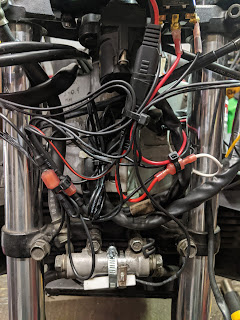My Amazon multi-function signals arrived and I made a trek to Tractor Supply Company to get an oval LED tail light and mount. I want everything to be LED to help conserve what little output the Hurricane's electrical system can pump out. I originally shopped the net for an LED tail light but so many are not DOT approved and have bad reviews. I'd really prefer to not have a dim, essentially useless tail light. On AdvRider, I saw a KLR build where the guy used two oval trailer in a V formation and it gave me the inspiration for this project.
The signals even came with a set of resistors.
As I mentioned, these are multi-function, tail or brake, and signal. I opted for signal and brake light as I'm not sure on the laws regarding red running lights on a motorcycle and I don't want them to distract from the actual brake light. I read some place that brake lights in a triangle formation are more attention grabbing, so yeah.
Lookin' good from the rear.
The LED flasher module I need from SuperBrightLEDs is on back order, so I stopped by CycleGear and grabbed one from SpeedMetal. After I purchased it, I noticed it was "specific" for you Yamaha.
You're not the boss of me sticker! I'm putting this on a Honda.
I was unsure if it would work since my OEM flasher has three wires. The kind associate at CycleGear assured me I could return it if it didn't work. Thankfully, it worked just fine! The OEM version has a dedicated ground, while the LED uses the ground from the light circuit.
Overall, I'm really happy with how well this all turned out. Everything fit just right and the wiring was simple. The running light is very bright and the combination of the brake light and brake function of the signals is very bright. In the future, I may add a tail light strobe like I put on my Ulysses.




















